Clinical Judgment in Nursing: SNPG962 Report on Promoting Excellence
VerifiedAdded on 2023/06/11
|7
|2110
|296
Report
AI Summary
This report examines the crucial role of clinical judgment in nursing, particularly within the context of promoting excellence in healthcare settings. It highlights the impact of workplace culture on nurses' ability to perform physical assessments and deliver holistic care. The 'Between the Flags' (BTF) system, implemented in NSW hospitals, is discussed as a key tool for early detection of patient deterioration. The report includes an assessment of a hypothetical patient case, demonstrating the application of clinical judgment through targeted questioning and further action planning. Strategies for achieving learning outcomes, such as applying knowledge in practice, consulting with mentors, and continuous self-assessment, are outlined. The importance of the BTF system in ensuring patient safety and supporting nursing staff is emphasized. The report concludes by referencing relevant literature on clinical judgment, decision-making, and nursing practice.
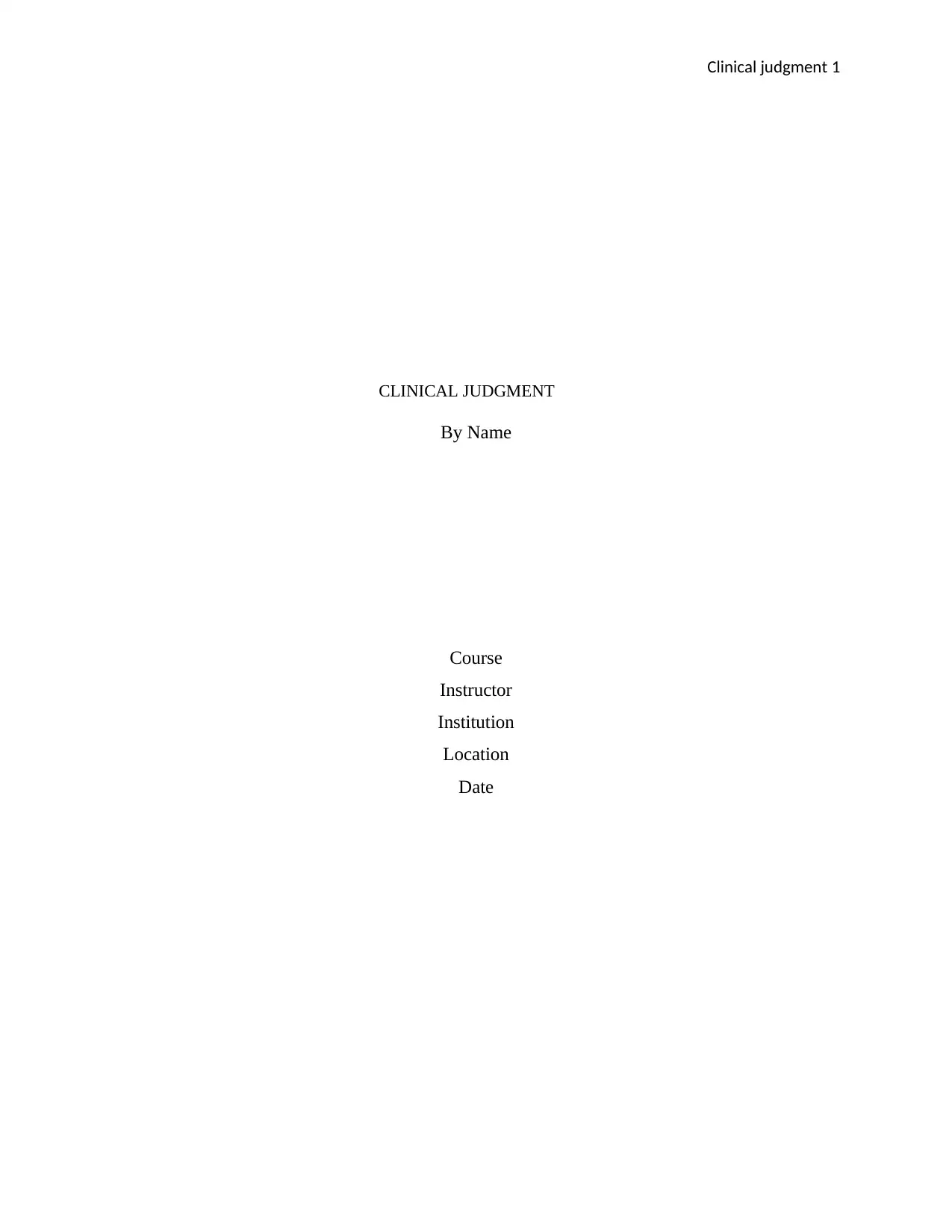
Clinical judgment 1
CLINICAL JUDGMENT
By Name
Course
Instructor
Institution
Location
Date
CLINICAL JUDGMENT
By Name
Course
Instructor
Institution
Location
Date
Paraphrase This Document
Need a fresh take? Get an instant paraphrase of this document with our AI Paraphraser
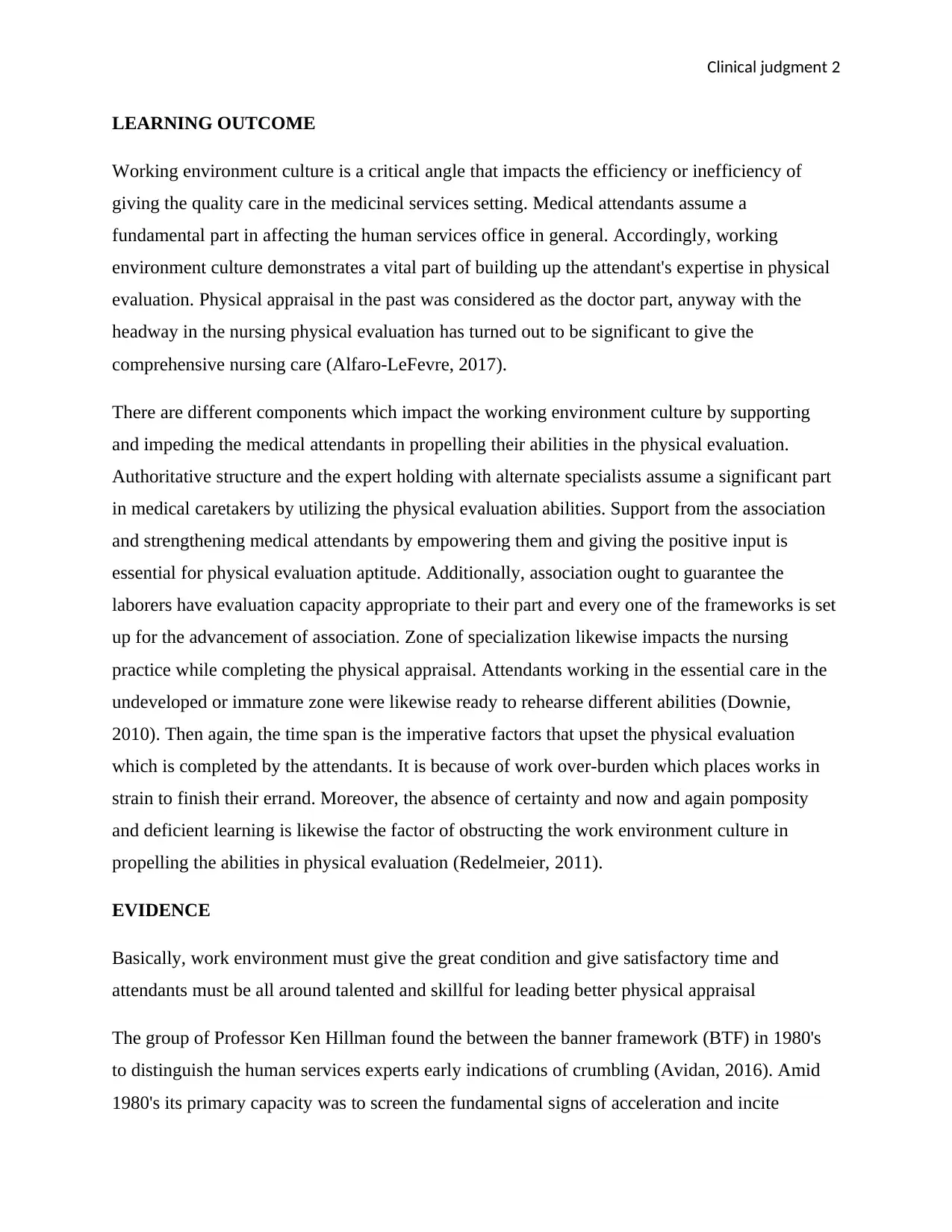
Clinical judgment 2
LEARNING OUTCOME
Working environment culture is a critical angle that impacts the efficiency or inefficiency of
giving the quality care in the medicinal services setting. Medical attendants assume a
fundamental part in affecting the human services office in general. Accordingly, working
environment culture demonstrates a vital part of building up the attendant's expertise in physical
evaluation. Physical appraisal in the past was considered as the doctor part, anyway with the
headway in the nursing physical evaluation has turned out to be significant to give the
comprehensive nursing care (Alfaro-LeFevre, 2017).
There are different components which impact the working environment culture by supporting
and impeding the medical attendants in propelling their abilities in the physical evaluation.
Authoritative structure and the expert holding with alternate specialists assume a significant part
in medical caretakers by utilizing the physical evaluation abilities. Support from the association
and strengthening medical attendants by empowering them and giving the positive input is
essential for physical evaluation aptitude. Additionally, association ought to guarantee the
laborers have evaluation capacity appropriate to their part and every one of the frameworks is set
up for the advancement of association. Zone of specialization likewise impacts the nursing
practice while completing the physical appraisal. Attendants working in the essential care in the
undeveloped or immature zone were likewise ready to rehearse different abilities (Downie,
2010). Then again, the time span is the imperative factors that upset the physical evaluation
which is completed by the attendants. It is because of work over-burden which places works in
strain to finish their errand. Moreover, the absence of certainty and now and again pomposity
and deficient learning is likewise the factor of obstructing the work environment culture in
propelling the abilities in physical evaluation (Redelmeier, 2011).
EVIDENCE
Basically, work environment must give the great condition and give satisfactory time and
attendants must be all around talented and skillful for leading better physical appraisal
The group of Professor Ken Hillman found the between the banner framework (BTF) in 1980's
to distinguish the human services experts early indications of crumbling (Avidan, 2016). Amid
1980's its primary capacity was to screen the fundamental signs of acceleration and incite
LEARNING OUTCOME
Working environment culture is a critical angle that impacts the efficiency or inefficiency of
giving the quality care in the medicinal services setting. Medical attendants assume a
fundamental part in affecting the human services office in general. Accordingly, working
environment culture demonstrates a vital part of building up the attendant's expertise in physical
evaluation. Physical appraisal in the past was considered as the doctor part, anyway with the
headway in the nursing physical evaluation has turned out to be significant to give the
comprehensive nursing care (Alfaro-LeFevre, 2017).
There are different components which impact the working environment culture by supporting
and impeding the medical attendants in propelling their abilities in the physical evaluation.
Authoritative structure and the expert holding with alternate specialists assume a significant part
in medical caretakers by utilizing the physical evaluation abilities. Support from the association
and strengthening medical attendants by empowering them and giving the positive input is
essential for physical evaluation aptitude. Additionally, association ought to guarantee the
laborers have evaluation capacity appropriate to their part and every one of the frameworks is set
up for the advancement of association. Zone of specialization likewise impacts the nursing
practice while completing the physical appraisal. Attendants working in the essential care in the
undeveloped or immature zone were likewise ready to rehearse different abilities (Downie,
2010). Then again, the time span is the imperative factors that upset the physical evaluation
which is completed by the attendants. It is because of work over-burden which places works in
strain to finish their errand. Moreover, the absence of certainty and now and again pomposity
and deficient learning is likewise the factor of obstructing the work environment culture in
propelling the abilities in physical evaluation (Redelmeier, 2011).
EVIDENCE
Basically, work environment must give the great condition and give satisfactory time and
attendants must be all around talented and skillful for leading better physical appraisal
The group of Professor Ken Hillman found the between the banner framework (BTF) in 1980's
to distinguish the human services experts early indications of crumbling (Avidan, 2016). Amid
1980's its primary capacity was to screen the fundamental signs of acceleration and incite
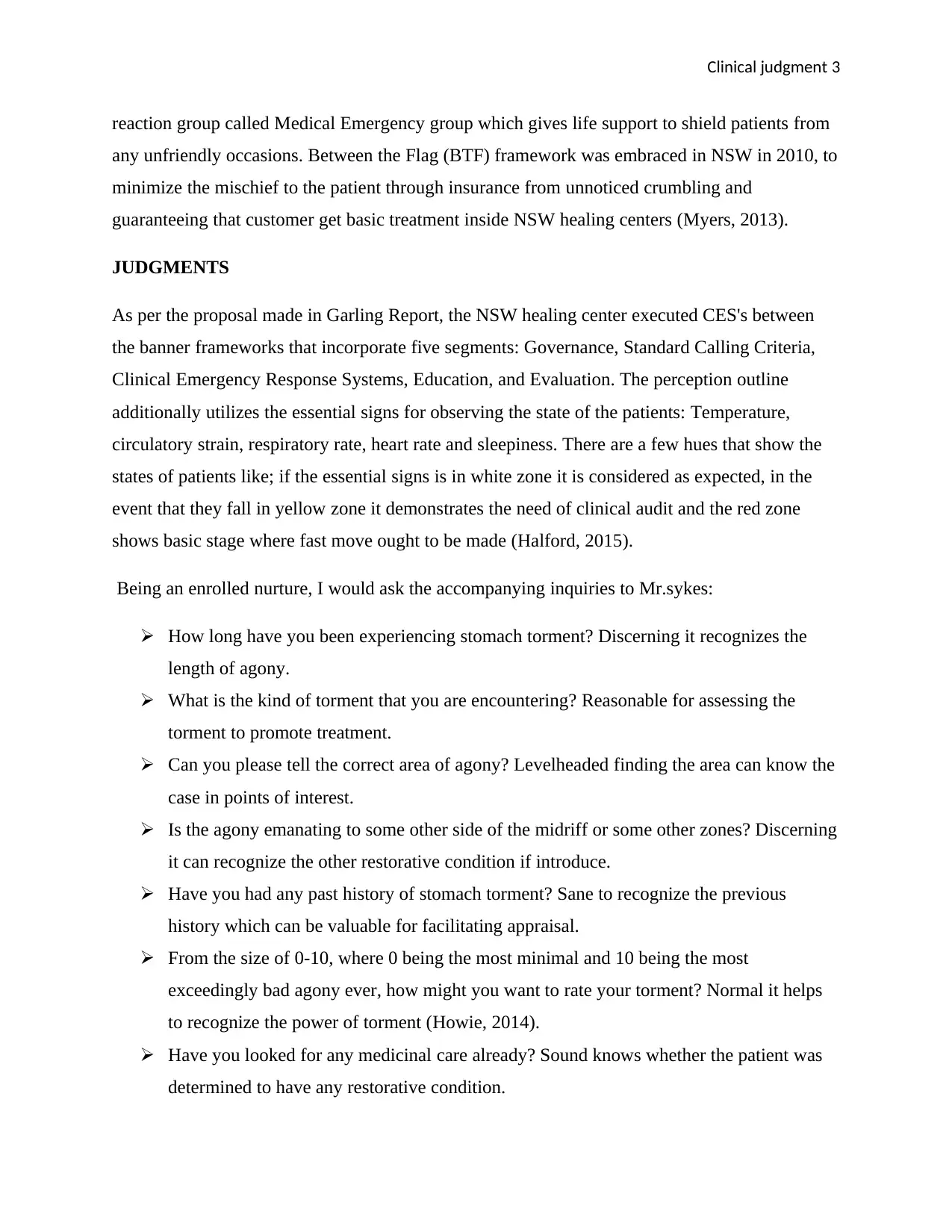
Clinical judgment 3
reaction group called Medical Emergency group which gives life support to shield patients from
any unfriendly occasions. Between the Flag (BTF) framework was embraced in NSW in 2010, to
minimize the mischief to the patient through insurance from unnoticed crumbling and
guaranteeing that customer get basic treatment inside NSW healing centers (Myers, 2013).
JUDGMENTS
As per the proposal made in Garling Report, the NSW healing center executed CES's between
the banner frameworks that incorporate five segments: Governance, Standard Calling Criteria,
Clinical Emergency Response Systems, Education, and Evaluation. The perception outline
additionally utilizes the essential signs for observing the state of the patients: Temperature,
circulatory strain, respiratory rate, heart rate and sleepiness. There are a few hues that show the
states of patients like; if the essential signs is in white zone it is considered as expected, in the
event that they fall in yellow zone it demonstrates the need of clinical audit and the red zone
shows basic stage where fast move ought to be made (Halford, 2015).
Being an enrolled nurture, I would ask the accompanying inquiries to Mr.sykes:
How long have you been experiencing stomach torment? Discerning it recognizes the
length of agony.
What is the kind of torment that you are encountering? Reasonable for assessing the
torment to promote treatment.
Can you please tell the correct area of agony? Levelheaded finding the area can know the
case in points of interest.
Is the agony emanating to some other side of the midriff or some other zones? Discerning
it can recognize the other restorative condition if introduce.
Have you had any past history of stomach torment? Sane to recognize the previous
history which can be valuable for facilitating appraisal.
From the size of 0-10, where 0 being the most minimal and 10 being the most
exceedingly bad agony ever, how might you want to rate your torment? Normal it helps
to recognize the power of torment (Howie, 2014).
Have you looked for any medicinal care already? Sound knows whether the patient was
determined to have any restorative condition.
reaction group called Medical Emergency group which gives life support to shield patients from
any unfriendly occasions. Between the Flag (BTF) framework was embraced in NSW in 2010, to
minimize the mischief to the patient through insurance from unnoticed crumbling and
guaranteeing that customer get basic treatment inside NSW healing centers (Myers, 2013).
JUDGMENTS
As per the proposal made in Garling Report, the NSW healing center executed CES's between
the banner frameworks that incorporate five segments: Governance, Standard Calling Criteria,
Clinical Emergency Response Systems, Education, and Evaluation. The perception outline
additionally utilizes the essential signs for observing the state of the patients: Temperature,
circulatory strain, respiratory rate, heart rate and sleepiness. There are a few hues that show the
states of patients like; if the essential signs is in white zone it is considered as expected, in the
event that they fall in yellow zone it demonstrates the need of clinical audit and the red zone
shows basic stage where fast move ought to be made (Halford, 2015).
Being an enrolled nurture, I would ask the accompanying inquiries to Mr.sykes:
How long have you been experiencing stomach torment? Discerning it recognizes the
length of agony.
What is the kind of torment that you are encountering? Reasonable for assessing the
torment to promote treatment.
Can you please tell the correct area of agony? Levelheaded finding the area can know the
case in points of interest.
Is the agony emanating to some other side of the midriff or some other zones? Discerning
it can recognize the other restorative condition if introduce.
Have you had any past history of stomach torment? Sane to recognize the previous
history which can be valuable for facilitating appraisal.
From the size of 0-10, where 0 being the most minimal and 10 being the most
exceedingly bad agony ever, how might you want to rate your torment? Normal it helps
to recognize the power of torment (Howie, 2014).
Have you looked for any medicinal care already? Sound knows whether the patient was
determined to have any restorative condition.
⊘ This is a preview!⊘
Do you want full access?
Subscribe today to unlock all pages.

Trusted by 1+ million students worldwide
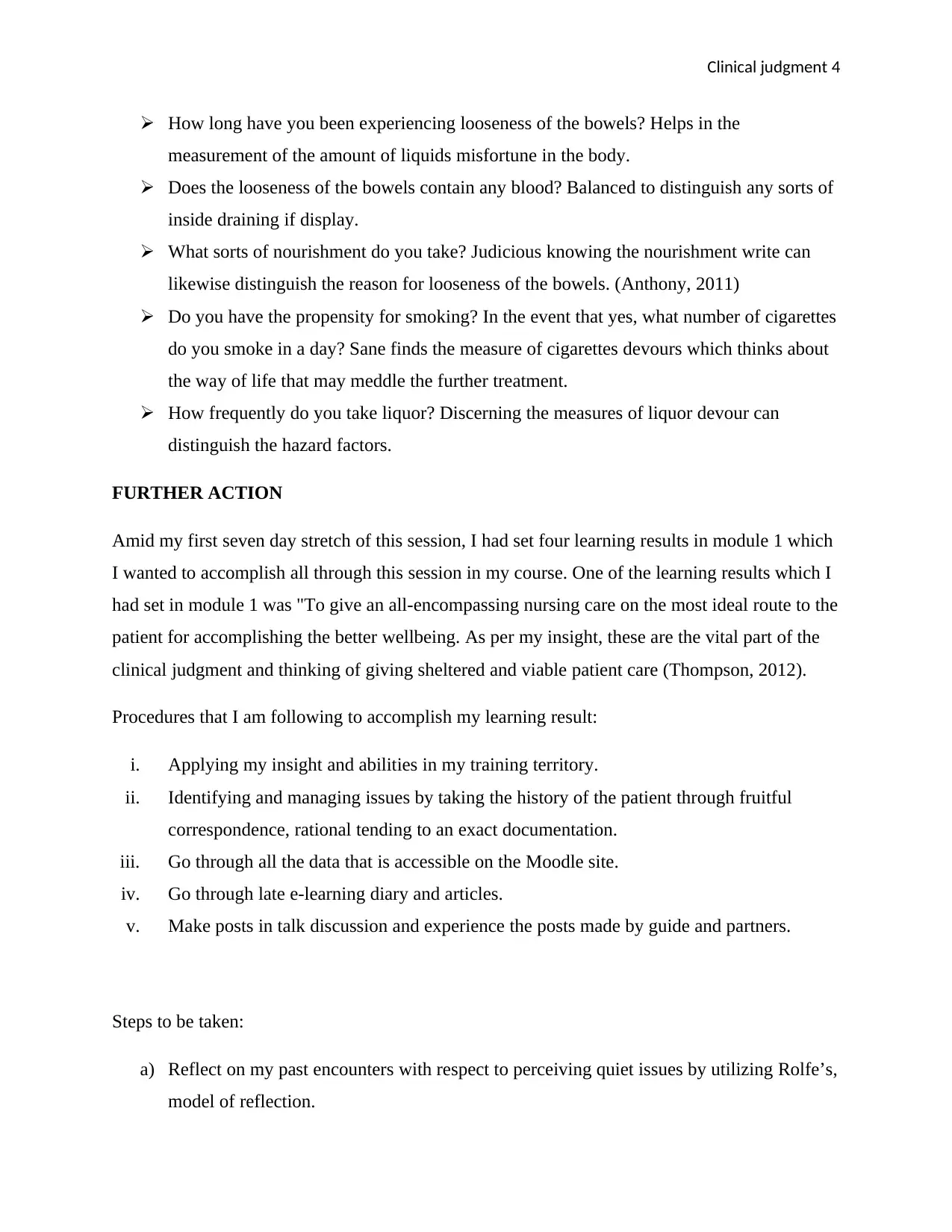
Clinical judgment 4
How long have you been experiencing looseness of the bowels? Helps in the
measurement of the amount of liquids misfortune in the body.
Does the looseness of the bowels contain any blood? Balanced to distinguish any sorts of
inside draining if display.
What sorts of nourishment do you take? Judicious knowing the nourishment write can
likewise distinguish the reason for looseness of the bowels. (Anthony, 2011)
Do you have the propensity for smoking? In the event that yes, what number of cigarettes
do you smoke in a day? Sane finds the measure of cigarettes devours which thinks about
the way of life that may meddle the further treatment.
How frequently do you take liquor? Discerning the measures of liquor devour can
distinguish the hazard factors.
FURTHER ACTION
Amid my first seven day stretch of this session, I had set four learning results in module 1 which
I wanted to accomplish all through this session in my course. One of the learning results which I
had set in module 1 was "To give an all-encompassing nursing care on the most ideal route to the
patient for accomplishing the better wellbeing. As per my insight, these are the vital part of the
clinical judgment and thinking of giving sheltered and viable patient care (Thompson, 2012).
Procedures that I am following to accomplish my learning result:
i. Applying my insight and abilities in my training territory.
ii. Identifying and managing issues by taking the history of the patient through fruitful
correspondence, rational tending to an exact documentation.
iii. Go through all the data that is accessible on the Moodle site.
iv. Go through late e-learning diary and articles.
v. Make posts in talk discussion and experience the posts made by guide and partners.
Steps to be taken:
a) Reflect on my past encounters with respect to perceiving quiet issues by utilizing Rolfe’s,
model of reflection.
How long have you been experiencing looseness of the bowels? Helps in the
measurement of the amount of liquids misfortune in the body.
Does the looseness of the bowels contain any blood? Balanced to distinguish any sorts of
inside draining if display.
What sorts of nourishment do you take? Judicious knowing the nourishment write can
likewise distinguish the reason for looseness of the bowels. (Anthony, 2011)
Do you have the propensity for smoking? In the event that yes, what number of cigarettes
do you smoke in a day? Sane finds the measure of cigarettes devours which thinks about
the way of life that may meddle the further treatment.
How frequently do you take liquor? Discerning the measures of liquor devour can
distinguish the hazard factors.
FURTHER ACTION
Amid my first seven day stretch of this session, I had set four learning results in module 1 which
I wanted to accomplish all through this session in my course. One of the learning results which I
had set in module 1 was "To give an all-encompassing nursing care on the most ideal route to the
patient for accomplishing the better wellbeing. As per my insight, these are the vital part of the
clinical judgment and thinking of giving sheltered and viable patient care (Thompson, 2012).
Procedures that I am following to accomplish my learning result:
i. Applying my insight and abilities in my training territory.
ii. Identifying and managing issues by taking the history of the patient through fruitful
correspondence, rational tending to an exact documentation.
iii. Go through all the data that is accessible on the Moodle site.
iv. Go through late e-learning diary and articles.
v. Make posts in talk discussion and experience the posts made by guide and partners.
Steps to be taken:
a) Reflect on my past encounters with respect to perceiving quiet issues by utilizing Rolfe’s,
model of reflection.
Paraphrase This Document
Need a fresh take? Get an instant paraphrase of this document with our AI Paraphraser
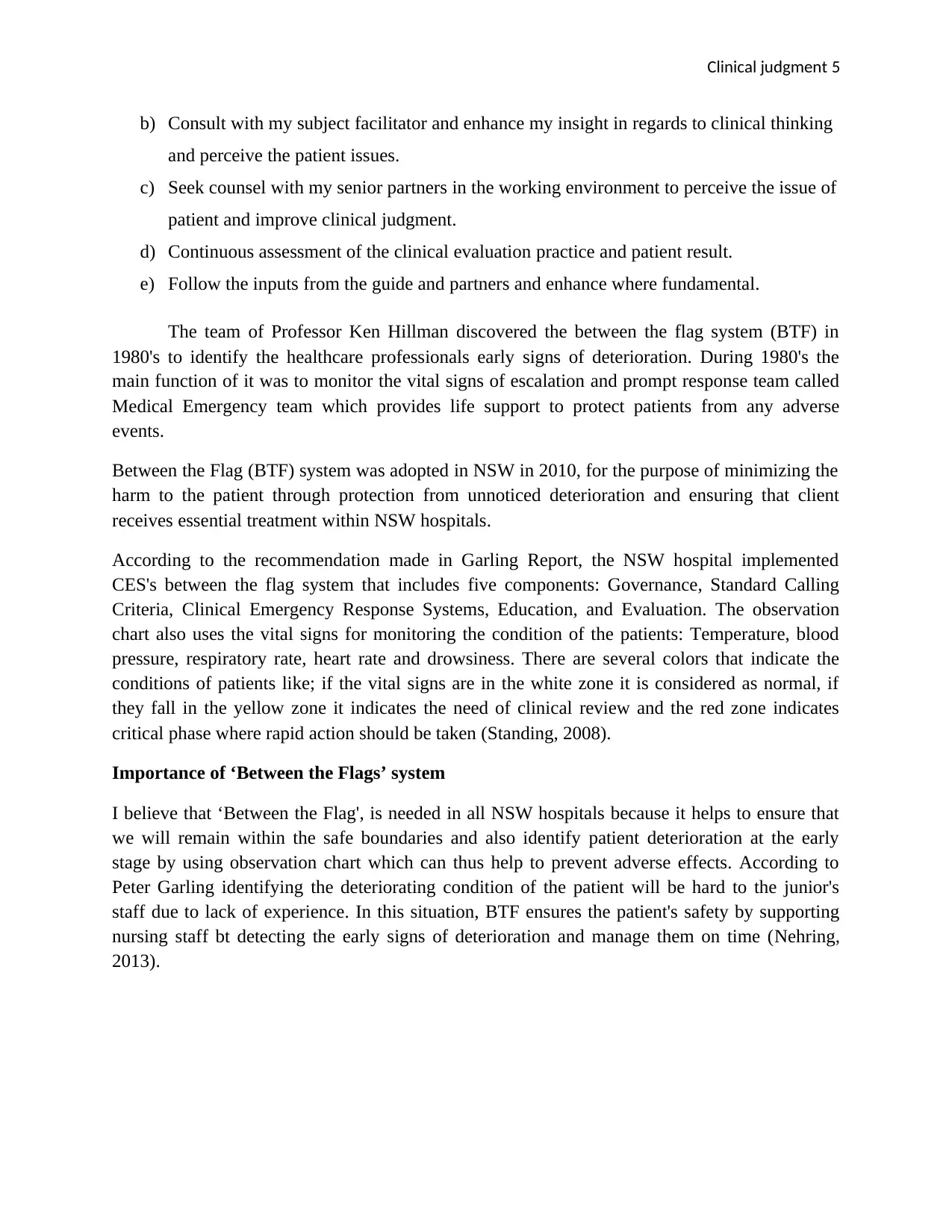
Clinical judgment 5
b) Consult with my subject facilitator and enhance my insight in regards to clinical thinking
and perceive the patient issues.
c) Seek counsel with my senior partners in the working environment to perceive the issue of
patient and improve clinical judgment.
d) Continuous assessment of the clinical evaluation practice and patient result.
e) Follow the inputs from the guide and partners and enhance where fundamental.
The team of Professor Ken Hillman discovered the between the flag system (BTF) in
1980's to identify the healthcare professionals early signs of deterioration. During 1980's the
main function of it was to monitor the vital signs of escalation and prompt response team called
Medical Emergency team which provides life support to protect patients from any adverse
events.
Between the Flag (BTF) system was adopted in NSW in 2010, for the purpose of minimizing the
harm to the patient through protection from unnoticed deterioration and ensuring that client
receives essential treatment within NSW hospitals.
According to the recommendation made in Garling Report, the NSW hospital implemented
CES's between the flag system that includes five components: Governance, Standard Calling
Criteria, Clinical Emergency Response Systems, Education, and Evaluation. The observation
chart also uses the vital signs for monitoring the condition of the patients: Temperature, blood
pressure, respiratory rate, heart rate and drowsiness. There are several colors that indicate the
conditions of patients like; if the vital signs are in the white zone it is considered as normal, if
they fall in the yellow zone it indicates the need of clinical review and the red zone indicates
critical phase where rapid action should be taken (Standing, 2008).
Importance of ‘Between the Flags’ system
I believe that ‘Between the Flag', is needed in all NSW hospitals because it helps to ensure that
we will remain within the safe boundaries and also identify patient deterioration at the early
stage by using observation chart which can thus help to prevent adverse effects. According to
Peter Garling identifying the deteriorating condition of the patient will be hard to the junior's
staff due to lack of experience. In this situation, BTF ensures the patient's safety by supporting
nursing staff bt detecting the early signs of deterioration and manage them on time (Nehring,
2013).
b) Consult with my subject facilitator and enhance my insight in regards to clinical thinking
and perceive the patient issues.
c) Seek counsel with my senior partners in the working environment to perceive the issue of
patient and improve clinical judgment.
d) Continuous assessment of the clinical evaluation practice and patient result.
e) Follow the inputs from the guide and partners and enhance where fundamental.
The team of Professor Ken Hillman discovered the between the flag system (BTF) in
1980's to identify the healthcare professionals early signs of deterioration. During 1980's the
main function of it was to monitor the vital signs of escalation and prompt response team called
Medical Emergency team which provides life support to protect patients from any adverse
events.
Between the Flag (BTF) system was adopted in NSW in 2010, for the purpose of minimizing the
harm to the patient through protection from unnoticed deterioration and ensuring that client
receives essential treatment within NSW hospitals.
According to the recommendation made in Garling Report, the NSW hospital implemented
CES's between the flag system that includes five components: Governance, Standard Calling
Criteria, Clinical Emergency Response Systems, Education, and Evaluation. The observation
chart also uses the vital signs for monitoring the condition of the patients: Temperature, blood
pressure, respiratory rate, heart rate and drowsiness. There are several colors that indicate the
conditions of patients like; if the vital signs are in the white zone it is considered as normal, if
they fall in the yellow zone it indicates the need of clinical review and the red zone indicates
critical phase where rapid action should be taken (Standing, 2008).
Importance of ‘Between the Flags’ system
I believe that ‘Between the Flag', is needed in all NSW hospitals because it helps to ensure that
we will remain within the safe boundaries and also identify patient deterioration at the early
stage by using observation chart which can thus help to prevent adverse effects. According to
Peter Garling identifying the deteriorating condition of the patient will be hard to the junior's
staff due to lack of experience. In this situation, BTF ensures the patient's safety by supporting
nursing staff bt detecting the early signs of deterioration and manage them on time (Nehring,
2013).
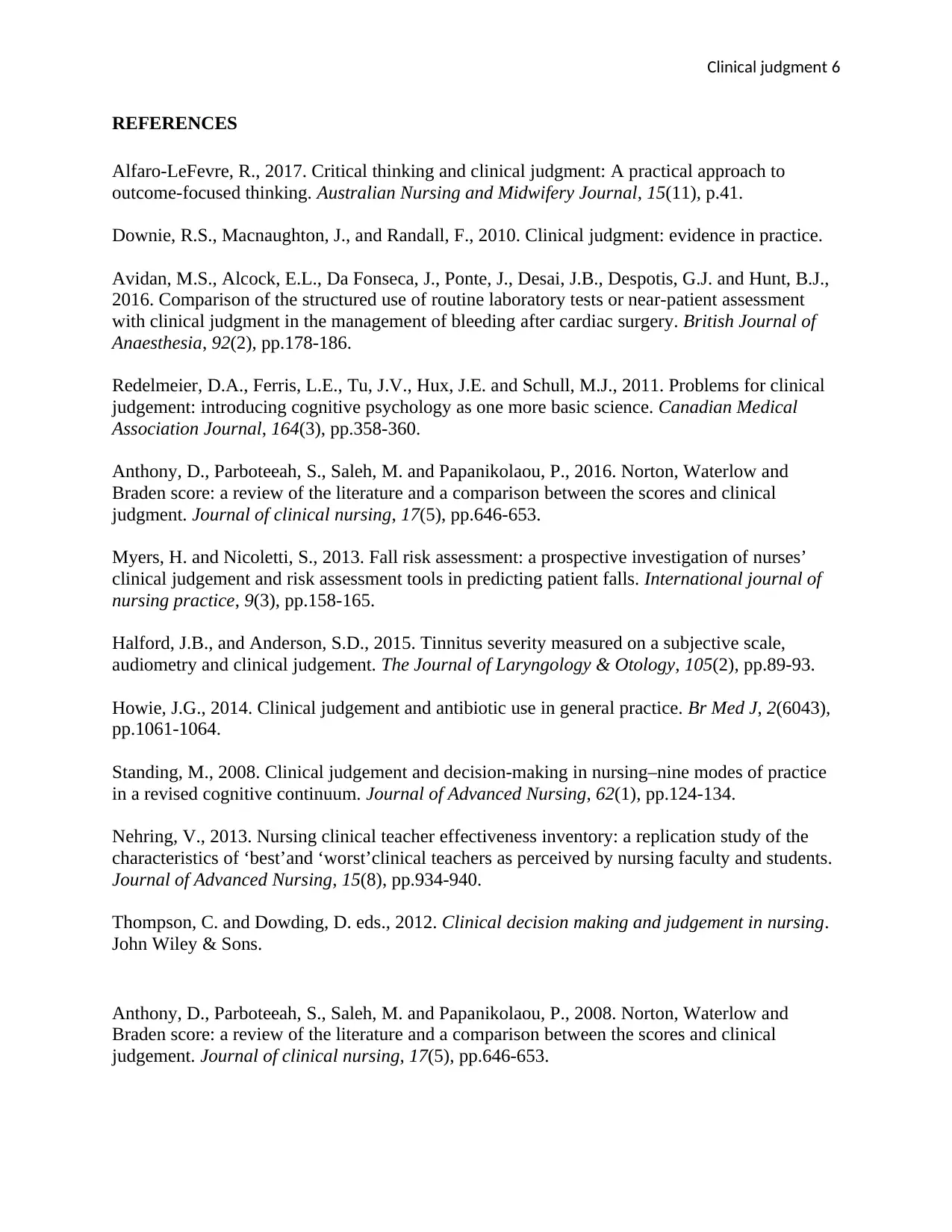
Clinical judgment 6
REFERENCES
Alfaro-LeFevre, R., 2017. Critical thinking and clinical judgment: A practical approach to
outcome-focused thinking. Australian Nursing and Midwifery Journal, 15(11), p.41.
Downie, R.S., Macnaughton, J., and Randall, F., 2010. Clinical judgment: evidence in practice.
Avidan, M.S., Alcock, E.L., Da Fonseca, J., Ponte, J., Desai, J.B., Despotis, G.J. and Hunt, B.J.,
2016. Comparison of the structured use of routine laboratory tests or near-patient assessment
with clinical judgment in the management of bleeding after cardiac surgery. British Journal of
Anaesthesia, 92(2), pp.178-186.
Redelmeier, D.A., Ferris, L.E., Tu, J.V., Hux, J.E. and Schull, M.J., 2011. Problems for clinical
judgement: introducing cognitive psychology as one more basic science. Canadian Medical
Association Journal, 164(3), pp.358-360.
Anthony, D., Parboteeah, S., Saleh, M. and Papanikolaou, P., 2016. Norton, Waterlow and
Braden score: a review of the literature and a comparison between the scores and clinical
judgment. Journal of clinical nursing, 17(5), pp.646-653.
Myers, H. and Nicoletti, S., 2013. Fall risk assessment: a prospective investigation of nurses’
clinical judgement and risk assessment tools in predicting patient falls. International journal of
nursing practice, 9(3), pp.158-165.
Halford, J.B., and Anderson, S.D., 2015. Tinnitus severity measured on a subjective scale,
audiometry and clinical judgement. The Journal of Laryngology & Otology, 105(2), pp.89-93.
Howie, J.G., 2014. Clinical judgement and antibiotic use in general practice. Br Med J, 2(6043),
pp.1061-1064.
Standing, M., 2008. Clinical judgement and decision‐making in nursing–nine modes of practice
in a revised cognitive continuum. Journal of Advanced Nursing, 62(1), pp.124-134.
Nehring, V., 2013. Nursing clinical teacher effectiveness inventory: a replication study of the
characteristics of ‘best’and ‘worst’clinical teachers as perceived by nursing faculty and students.
Journal of Advanced Nursing, 15(8), pp.934-940.
Thompson, C. and Dowding, D. eds., 2012. Clinical decision making and judgement in nursing.
John Wiley & Sons.
Anthony, D., Parboteeah, S., Saleh, M. and Papanikolaou, P., 2008. Norton, Waterlow and
Braden score: a review of the literature and a comparison between the scores and clinical
judgement. Journal of clinical nursing, 17(5), pp.646-653.
REFERENCES
Alfaro-LeFevre, R., 2017. Critical thinking and clinical judgment: A practical approach to
outcome-focused thinking. Australian Nursing and Midwifery Journal, 15(11), p.41.
Downie, R.S., Macnaughton, J., and Randall, F., 2010. Clinical judgment: evidence in practice.
Avidan, M.S., Alcock, E.L., Da Fonseca, J., Ponte, J., Desai, J.B., Despotis, G.J. and Hunt, B.J.,
2016. Comparison of the structured use of routine laboratory tests or near-patient assessment
with clinical judgment in the management of bleeding after cardiac surgery. British Journal of
Anaesthesia, 92(2), pp.178-186.
Redelmeier, D.A., Ferris, L.E., Tu, J.V., Hux, J.E. and Schull, M.J., 2011. Problems for clinical
judgement: introducing cognitive psychology as one more basic science. Canadian Medical
Association Journal, 164(3), pp.358-360.
Anthony, D., Parboteeah, S., Saleh, M. and Papanikolaou, P., 2016. Norton, Waterlow and
Braden score: a review of the literature and a comparison between the scores and clinical
judgment. Journal of clinical nursing, 17(5), pp.646-653.
Myers, H. and Nicoletti, S., 2013. Fall risk assessment: a prospective investigation of nurses’
clinical judgement and risk assessment tools in predicting patient falls. International journal of
nursing practice, 9(3), pp.158-165.
Halford, J.B., and Anderson, S.D., 2015. Tinnitus severity measured on a subjective scale,
audiometry and clinical judgement. The Journal of Laryngology & Otology, 105(2), pp.89-93.
Howie, J.G., 2014. Clinical judgement and antibiotic use in general practice. Br Med J, 2(6043),
pp.1061-1064.
Standing, M., 2008. Clinical judgement and decision‐making in nursing–nine modes of practice
in a revised cognitive continuum. Journal of Advanced Nursing, 62(1), pp.124-134.
Nehring, V., 2013. Nursing clinical teacher effectiveness inventory: a replication study of the
characteristics of ‘best’and ‘worst’clinical teachers as perceived by nursing faculty and students.
Journal of Advanced Nursing, 15(8), pp.934-940.
Thompson, C. and Dowding, D. eds., 2012. Clinical decision making and judgement in nursing.
John Wiley & Sons.
Anthony, D., Parboteeah, S., Saleh, M. and Papanikolaou, P., 2008. Norton, Waterlow and
Braden score: a review of the literature and a comparison between the scores and clinical
judgement. Journal of clinical nursing, 17(5), pp.646-653.
⊘ This is a preview!⊘
Do you want full access?
Subscribe today to unlock all pages.

Trusted by 1+ million students worldwide
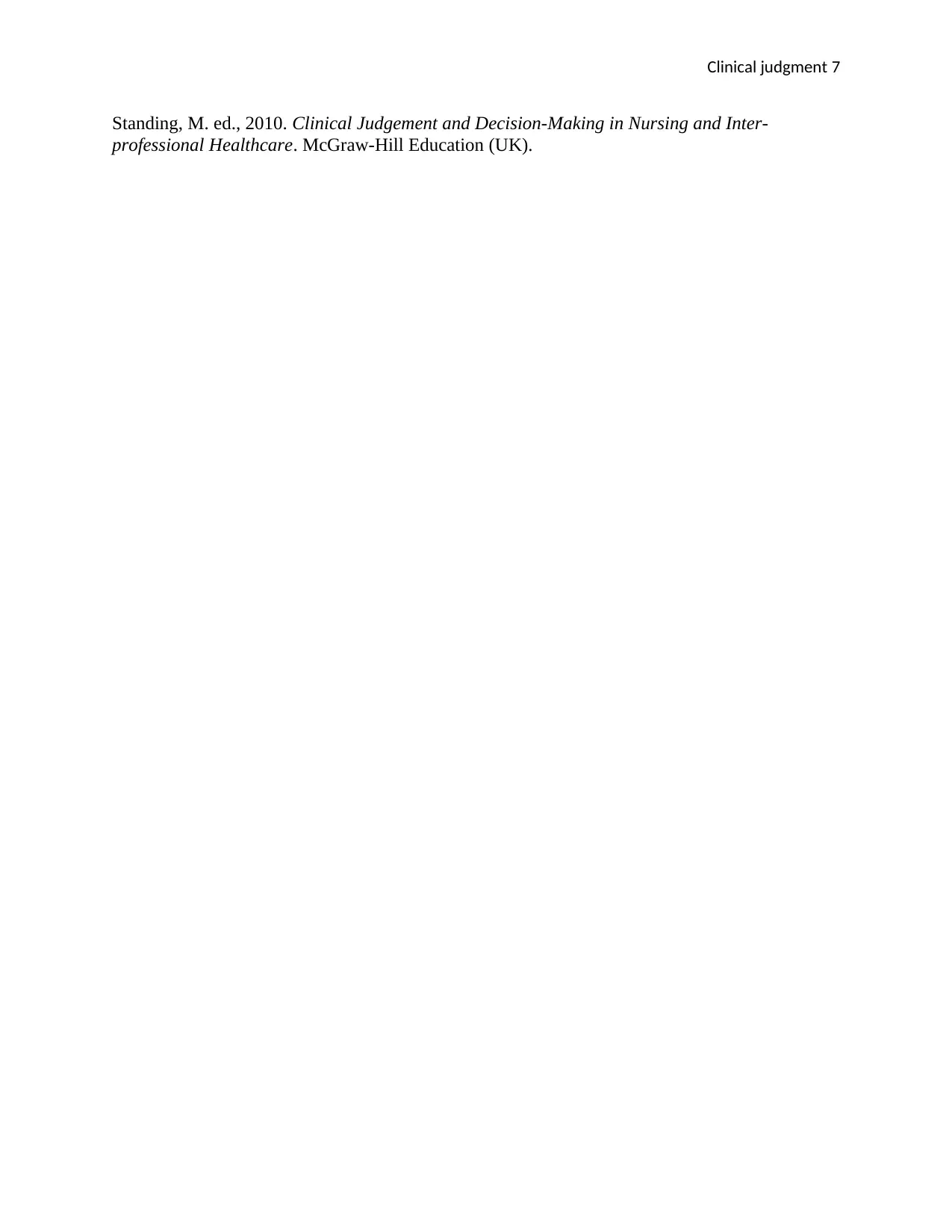
Clinical judgment 7
Standing, M. ed., 2010. Clinical Judgement and Decision-Making in Nursing and Inter-
professional Healthcare. McGraw-Hill Education (UK).
Standing, M. ed., 2010. Clinical Judgement and Decision-Making in Nursing and Inter-
professional Healthcare. McGraw-Hill Education (UK).
1 out of 7
Your All-in-One AI-Powered Toolkit for Academic Success.
+13062052269
info@desklib.com
Available 24*7 on WhatsApp / Email
![[object Object]](/_next/static/media/star-bottom.7253800d.svg)
Unlock your academic potential
Copyright © 2020–2025 A2Z Services. All Rights Reserved. Developed and managed by ZUCOL.


